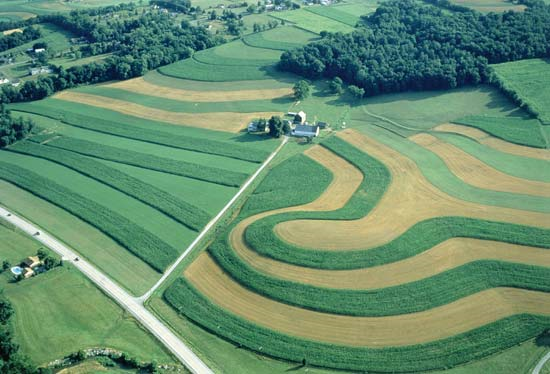Strip cropping is a method of farming used when a slope is too steep or too long, or otherwise, when one does not have an alternative method of preventing soil erosion. It alternates strips of closely sown crops such as hay, wheat, or other small grains with strips of row crops, such as corn, soybeans, cotton, or sugar beets. Strip cropping helps to stop soil erosion by creating natural dams for water, helping to preserve the strength of the soil. Certain layers of plants will absorb minerals and water from the soil more effectively than others. When water reaches the weaker soil that lacks the minerals needed to make it stronger, it normally washes it away. When strips of soil are strong enough to slow down water from moving through them, the weaker soil can't wash away like it normally would. Because of this, farmland stays fertile much longer. There is no available information on the extent of strip cropping in Europe. The practice has been widespread in North America as a means of mitigating soil erosion from wind and water.

Strip cropping along contour lines (UK)
| Benefits | Level |
|---|---|
|
BP2 - Slow runoff
|
High
|
|
BP6 - Increase infiltration and/or groundwater recharge
|
Medium
|
|
BP7 - Increase soil water retention
|
Low
|
|
BP10 - Reduce erosion and/or sediment delivery
|
High
|
|
BP11 - Improve soils
|
Medium
|
|
ES6 - Groundwater/aquifer recharge
|
Medium
|
|
ES7 - Flood risk reduction
|
Medium
|
|
ES8 - Erosion/sediment control
|
High
|
|
ES9 - Filtration of pollutants
|
Medium
|
|
PO3 - Improving status of hydromorphology quality elements
|
Medium
|
|
PO5 - Improving quantitative status
|
Medium
|
|
PO7 - Prevent surface water status deterioration
|
Medium
|
|
PO9 - Take adequate and co-ordinated measures to reduce flood risks
|
High
|
|
PO11 - Better protection for ecosystems and more use of Green Infrastructure
|
High
|
|
PO12 - More sustainable agriculture and forestry
|
Medium
|
|
PO14 - Prevention of biodiversity loss
|
Medium
|
